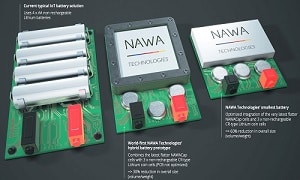- The number of IoT devices in the world is estimated to grow to great extent, making connectivity play an even more increasing role in our lives
- Challenges are in the form of effectively providing power to these. Ultracapacitors provide the answer.
 As the world becomes more connected, the role of IoT devices in our daily lives has become crucial – from providing convenience in domestic applications with the help of wifi-enabled electrical appliances such as smart meters to facilitating better monitoring of products for improved quality. IoT devices can be found everywhere from our homes to extreme environments be it deep under the sea or at altitude in aerospace.
As the world becomes more connected, the role of IoT devices in our daily lives has become crucial – from providing convenience in domestic applications with the help of wifi-enabled electrical appliances such as smart meters to facilitating better monitoring of products for improved quality. IoT devices can be found everywhere from our homes to extreme environments be it deep under the sea or at altitude in aerospace.
The next-generation ultracapacitors are set to revolutionise the growing global market for IoT devices by offering huge benefits in operational lifetime, cost, efficiency, safety and environmental impact.
However, there are major challenges around the performance of IoT devices, raising the question of how to power these devices efficiently, cost-effectively and with minimal environmental impact.
Given this, NAWA Technologies, a provider of electronics storage solution, presents the NAWACap ultracapacitors that are based on carbon. The NAWACaps can be packaged into small, flat cells and withstand extremes temperature and the harsh environments, making them an ideal match for IoT sensors that have to cope with high current peaks. Another benefit is that these capacitors come with long lifetime and therefore do not need to be replaced.
Ronald De Graaf, Sales Manager for IoT at NAWA Technologies says, “Many IoT devices spend most of their lives on standby, requiring a low amount of energy. But when the device needs to send a signal, a short burst of energy is required. For example, in the oil and gas industry, when a transfer of pressure data is sent from a drill on the seafloor to a rig on the surface. If you then combine the long-term energy requirement with a remote location and extreme environment, an energy solution that is only based on a conventional battery is just too large and expensive. Our concept is the hybridization of our NAWACap ultracapacitors with conventional batteries, resulting in the perfect solution for these applications, reducing the size and improving performance.”
Compact battery and better data transmission
IoT devices need to utilise many types of battery technologies, from non-rechargeable primary batteries such as regular AA or AAA alkaline to lithium primary cells to rechargeable lithium-ion batteries, but they need to provide repeated power bursts for transmission lowers their lifetime, causing early failures or heat problems in the circuitry. Along with that, lithium is a finite resource and has issues around recyclability and safety. Greener solutions, such as energy harvesters can supply a sensor with low-level ‘standby’ energy but not the short bursts of energy required for data transfer.
Ultracapacitors can meet the power requirements of an IoT device during data transmission by combining with battery.
“Combining our NAWACap ultracapacitors with a lithium cell to create a ‘hybrid’ battery, has many advantages. For example, a GPS tracking device, often used to track valuable assets or integrated into the collar of a pet, uses a non-rechargeable AA lithium battery, but this is very bulky,” continues Ronald De Graaf. “Integrate NAWACap and you could immediately reduce the reliance on lithium AA to AAA-sized batteries with superior performance, including the same or even an extended operational lifetime. One could also combine NAWACap with a coin cell resulting in an even flatter, lighter package with even better lifetime.”
Pascal Boulanger, Founder, Chairman of the board, CTO and COO added, “We can integrate our ultracapacitors with lithium rechargeable or non-rechargeable batteries like alkaline batteries, creating a system that is 80 per cent lighter and 60 per cent smaller, an overall reduction in volume and weight of more than 60 per cent.
Ulrik Grape, CEO of NAWA Technologies adds, “Along with substantial savings through increased energy efficiency and maintenance-free systems, it is also important to consider the indirect environmental benefits. Our NAWACap technology requires only abundantly available, non-toxic, disposable and recyclable materials. As a result, NAWA’s technology provides and supports economical, environmentally friendly and safe solutions for the IoT market.”
NAWA Technologies begins the mass production phase over the coming year and expects to achieve a capacity of over one million cells per month. In addition to the IoT markets, these cells will be used globally in a wide range of electrical systems including power tools and automated guided vehicles. Another key market is the automotive industry in hybrid cars, battery electric vehicles (BEVs) and fuel cell vehicles (FCEVs) for rapidly storing and deploying energy from regenerative braking systems, thus increasing energy efficiency.





